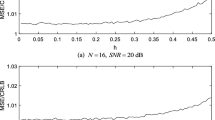Abstract
The problem of adaptively detecting two sinusoids corrupted by noise is considered, with emphasis on resolution properties. The approach is to form a spectral estimate from the coefficients of a Δ-step-ahead adaptive predictor. A theoretical analysis reveals that attention to the choice of the prediction horizon Δ gives a distinct improvement in the spectral estimate and in the resolution of the signals. The theoretical results are illustrated with numerical examples. Comparisons with previously suggested techniques are also made.
Similar content being viewed by others
References
B. Widrowet al., “Adaptive Noise Canceling Principles and Applications.”Proc. IEEE 63 1975, 1692–1716.
L.J. Griffiths, “Rapid Measurement of Digital Instantaneous Frequency,”IEEE Trans. on Acoustics, Speech and Signal Processing ASSP-23 (1975), 209–222.
J.R. Zeidleret al., “Adaptive Enhancement of Multiple Sinusoids in Uncorrelated Noise,”IEEE Trans. on Acoustics, Speech and Signal Processing ASSP-26 (1978), 240–254.
J.R. Treichler, “Response of the Adaptive Line Enhancer to Chirped and Doppler-Shifted Sinusoids,”IEEE Trans. on Acoustics, Speech and Signal Processing ASSP-28 (1980), 343–348.
F.W. Symons, Jr., “Narrowband Interference Rejection Using the Complex Linear Prediction Filter,”IEEE Trans. on Acoustics, Speech and Signal Processing ASSP-26 (1978), 94–98.
V.U. Reddy,et al., “Optimized Lattice-Form Adaptive Line Enhancer for a Sinusoidal Signal in Broadband Noise,”IEEE Trans. on Acoustics, Speech and Signal Processing ASSP-29 (1981), 702–710.
D.W. Tufts and R. Kumaresan, “Improved Spectral Resolution II,”Proceedings of the IEEE Conference on Acoustics, Speech and Signal Processing, Denver, CO, April 1980.
L.J. Griffiths, “A Continuously-Adaptive Filter Implemented as a Lattice Structure,”Proceedings of the IEEE International Conference on Acoustics, Speech and Signal Processing, pp. 683–686, Hartford, CT, May 1977.
S.L. Marple, Jr., “Resolution of Conventional Fourier, Autoregressive, and Special ARMA Methods of Spectral Analysis,”Proceedings of the IEEE International Conference on Acoustics, Speech and Signal Processing, pp. 74–77, Hartford, CT, May 1977.
V.U. Reddy and A. Nehorai, “Response of the Adaptive Line Enhancer to a Sinusoid in Lowpass Noise,”Proc. IEEE,128, Pt. F (1981) 161–166.
S.M. Kay, “Noise Compensation for Autoregressive Spectral Estimates,”IEEE Trans. on Acoustics, Speech and Signal Processing ASSP-28 (1980), 292–303.
J.P. Burg, “A New Analysis Technique for Time Series Data,” NATO Adv. Study Inst. Signal Processing with Emphasis on Underwater Acoustics, The Netherlands, August 1968.
A. Nehorai and M. Morf, “Enhancement of Sinusoids in Colored Noise and Whitening Performance of Exact Least-Squares Predictors,” submitted toIEEE Trans. on Acoustics, Speech and Signal Processing.
S.W. Lang and J.H. McClellan, “Frequency Estimation with Maximum Entropy Spectral Estimates,”IEEE Trans. on Acoustics, Speech and Signal Processing,ASSP-28 (1980), 716–724.
A. Papoulis, “Maximum Entropy and Spectral Estimation: A Review,”IEEE Trans. on Acoustics, Speech and Signal Processing,ASSP-29 (1981), 1176–1186.
Author information
Authors and Affiliations
Additional information
This work was supported in part by the Joint Services Electronics Program under Contract DAAG29-79-0047, the National Science Foundation under Grant Eng78-10003, and the Air Force Office of Scientific Research under Contract AF49-620-79-C-0058.
Rights and permissions
About this article
Cite this article
Egardt, B., Kailath, T. & Reddy, V.U. High-resolution spectral analysis using multiple-interval adaptive prediction. Circuits Systems and Signal Process 2, 421–443 (1983). https://doi.org/10.1007/BF01599163
Received:
Issue Date:
DOI: https://doi.org/10.1007/BF01599163




